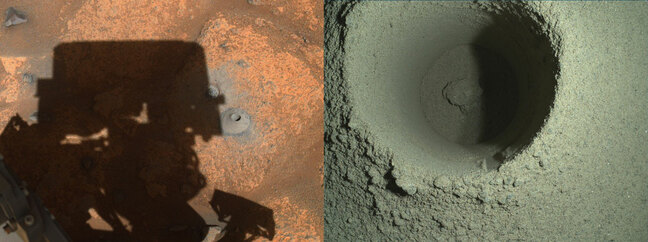This article is more than 1 year old
NASA blames the wrong kind of Martian rock for Perseverance sample failure
Not a hardware or software bug, for a change
Mars rover Perseverance failed in its first attempt to collect a sample of rock from the Red Planet because the material crumbled to dust, NASA scientists have said.
Last week, the nuke-powered science lab extended its robotic arm to bore 7cm into the seemingly hard surface, gather a core of material, and bottle it in a sample tube. Although its equipment appeared to be working fine, Perseverance came up empty handed.
A closer look confirmed there was nothing wrong with the trundle bot’s software or hardware. Instead, it's the rock that is to blame. Images from the WATSON camera onboard shows the regolith simply disintegrated, leaving no solid core to collect.

The hole created by Perseverance in the rocky surface, left, with a close-up view, right ... Credit: NASA/JPL-Caltech/MSSS
Click to enlarge, or here for the left photo, and here for the right
“Depth measurements of the borehole derived from the merge of image products from WATSON along with the image itself lead us to believe that the coring activity in this unusual rock resulted only in powder/small fragments which were not retained due to their size and the lack of any significant chunk of a core,” said Louise Jandura, Chief Engineer for Sampling and Caching at NASA.
“It appears that the rock was not robust enough to produce a core. Some material is visible in the bottom of the hole. The material from the desired core is likely either in the bottom of the hole, in the cuttings pile, or some combination of both. We are unable to distinguish further given the measurement uncertainties.”
- NASA comes up empty on Perseverance rover's first Mars sample drilling attempt
- NASA warns Mars: We're about to laser your rocks and start stealing them
- NASA talks up Perseverance Mars rover's self-driving rock-avoiding abilities
- Watch the moment China's Zhurong rover lands on Mars, hear it truckin' for the first time
It’s the first time NASA has attempted to collect and store samples of Martian rock. More than 90 staff members, who worked on this particular part of the mission and were left disappointed after the failure, can breathe a sigh of relief knowing the glitch had nothing to do with the Perseverance's design.
The rover will be directed to the South Seitah region in the Jezero crater, where scientists believe the rock will be less brittle. Perseverance will attempt to collect a solid sample again in early September, and hopefully succeed on its next go.
“The hardware performed as commanded but the rock did not cooperate this time. It reminds me yet again of the nature of exploration. A specific result is never guaranteed no matter how much you prepare. Despite this result, science and engineering have progressed,” Jandura said.
Any samples Perseverance successfully stores will be kept inside tubes for a future spacecraft or robots to collect and return back to Earth, where scientists can analyze them for signs of ancient microbial life in labs. ®
